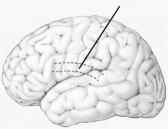A) semantic
B) phonetic
C) lexical
D) deep
E) phonological
Correct Answer

verified
Correct Answer
verified
Multiple Choice
The Z lens was developed by
A) Zaidel.
B) Zalman Amit.
C) Zurif.
D) Zimbardo.
E) Zola-Morgan.
Correct Answer

verified
Correct Answer
verified
Multiple Choice
__________ first reported evidence of the lateralization of language functions, but he received little or no recognition for his insightful observations.
A) Dax
B) Broca
C) Wernicke
D) Hebb
E) Penfield
Correct Answer

verified
Correct Answer
verified
Multiple Choice
The study of how left and right hemispheres differ in their approach to cognitive tasks has led to the concept of a left hemisphere
A) interpreter.
B) reporter.
C) responder.
D) calculator.
E) scientist.
Correct Answer

verified
Correct Answer
verified
Multiple Choice
Apraxic patients display
A) muscle weakness on the left side of the body.
B) muscle weakness on the right side of the body.
C) abnormal spinal reflexes.
D) a serious disturbance of motor coordination.
E) none of the above
Correct Answer

verified
Correct Answer
verified
Multiple Choice
The left and right hemispheres are connected by the
A) fornix.
B) septum.
C) cerebral commissures.
D) cerebral ligaments.
E) arcuate fasciculus.
Correct Answer

verified
Correct Answer
verified
Multiple Choice
According to the Wernicke-Geschwind model, signals are carried from Wernicke's area to Broca's area via the left
A) corpus callosum.
B) arcuate fasciculus.
C) massa intermedia.
D) angular gyrus.
E) primary motor cortex.
Correct Answer

verified
Correct Answer
verified
Multiple Choice
Both the planum temporale and Heschl's gyrus are in
A) the temporal lobe.
B) the frontal lobe.
C) primary olfactory cortex.
D) Wernicke's area.
E) Broca's area.
Correct Answer

verified
Correct Answer
verified
Multiple Choice
Broca's area is in the
A) left hemisphere.
B) frontal lobe.
C) inferior prefrontal cortex.
D) all of the above
E) both A and B
Correct Answer

verified
Correct Answer
verified
Short Answer
According to the Wernicke-Geschwind model, word salad results from damage to __________.
Correct Answer

verified
Correct Answer
verified
Multiple Choice
During a test in which split-brain patients were asked to verbally specify which of two colors, red or green, had been presented in the left visual field, an interesting phenomenon was discovered. This phenomenon is
A) unilateral emotion.
B) cross-cuing.
C) the helping-hand phenomenon.
D) transfer of hircismus.
E) interhemispheric transfer of color.
Correct Answer

verified
Correct Answer
verified
Multiple Choice
The left-hemisphere is dominant for speech in
A) all left-handers and a few right-handers.
B) nearly all left-handers and a few right-handers.
C) nearly all right-handers and the majority of left-handers.
D) nearly all right-handers and only a few left-handers.
E) a few right-handers and even fewer left-handers.
Correct Answer

verified
Correct Answer
verified
Multiple Choice
The words "spleemer" and "twipple" are normally read aloud by a __________ procedure.
A) linguistic
B) semantic
C) phonetic
D) surface
E) lexical
Correct Answer

verified
Correct Answer
verified
Multiple Choice
During language tests, PET and fMRI typically reveal greater activity in
A) aphasics.
B) dyslexics.
C) the left hemisphere.
D) the right hemisphere.
E) males.
Correct Answer

verified
Correct Answer
verified
Multiple Choice
A pathological difficulty in reading is termed
A) phonemia.
B) aphasia.
C) dyslexia.
D) apraxia.
E) lexicalia.
Correct Answer

verified
Correct Answer
verified
Multiple Choice
Theoretically, Broca's area is to Wernicke's area as
A) speech production is to speech reception.
B) speech production is to language comprehension.
C) conduction aphasia is to receptive aphasia.
D) the frontal operculum is to the arcuate fasciculus.
E) word salad is to conduction aphasia.
Correct Answer

verified
Correct Answer
verified
Multiple Choice
As a result of mounting evidence that broad categories of cognitive function are not lateralized, research on the lateralization of function has started to focus on
A) language.
B) constituent cognitive processes.
C) emotion.
D) spatial ability.
E) cognitive tasks.
Correct Answer

verified
Correct Answer
verified
Multiple Choice
Electrical stimulation of sites in the left neocortex of conscious human patients often
A) disrupts language-related abilities, even when applied to sites outside the areas of the Wernicke-Geschwind model.
B) has similar disruptive effects at widely scattered sites.
C) has different effects at the same sites in different patients.
D) all of the above
E) none of the above
Correct Answer

verified
Correct Answer
verified
Short Answer
The hemispheres of split-brain patients can communicate with one another externally, through their behavior; this is called __________.
Correct Answer

verified
Correct Answer
verified
Multiple Choice
Which component of the Wernicke-Geschwind model is illustrated here? 
A) Broca's area
B) Wernicke's area
C) angular gyrus
D) arcuate fasciculus
E) auditory cortex
Correct Answer

verified
Correct Answer
verified
Showing 121 - 140 of 170
Related Exams